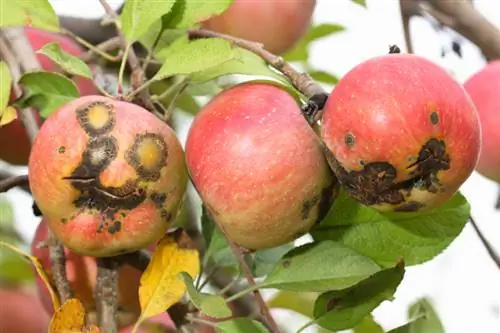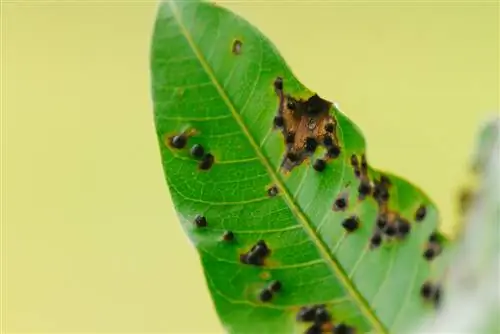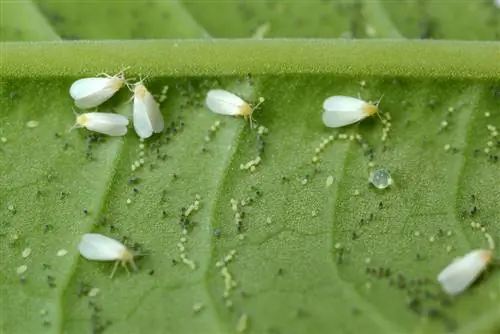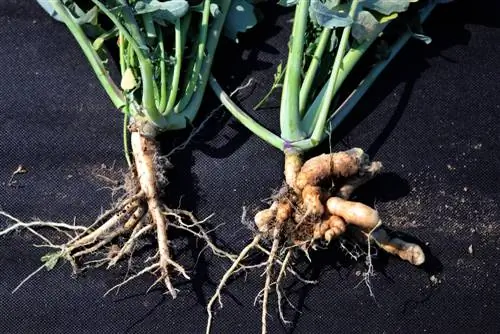- Author admin [email protected].
- Public 2023-12-16 16:46.
- Last modified 2025-01-23 11:22.
Potato blight, also known as late blight or brown rot, is a very common disease on potatoes. It is caused by the harmful fungus Phytophthora infestans, which primarily occurs in damp and rather cool weather. This is how you can prevent or fight an infection.
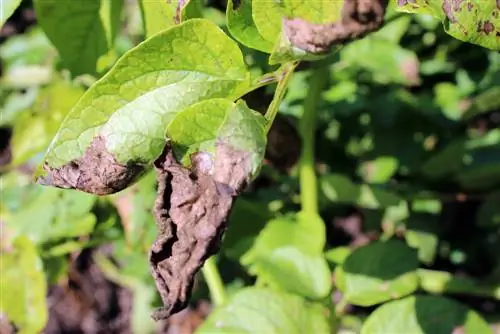
How can you prevent and combat potato blight?
To effectively prevent and combat potato blight, you should choose resistant potato varieties, adhere to the recommended planting distance, spatially separate nightshade plants, change cultivation areas annually, observe crop rotation, water directly onto the ground and fertilize moderately. If infested, remove and dispose of affected plant parts.
- The disease occurs not only in potatoes, but also in tomatoes and other nightshades.
- It is caused by the harmful fungus Phytophthora infestans and mainly occurs after damp weather.
- The dreaded tuber blight does not necessarily occur together with late blight, as only the above-ground parts of the plant can be affected.
- Choose potato varieties that are as resistant as possible for a culture, although early potatoes are generally less susceptible.
Causes and spread
In warm, humid weather, potatoes are infected by the dreaded late blight (also called potato blight, even if the disease does not only affect potatoes) between the beginning of July and the end of August - and into late autumn. The disease usually only occurs in connection with rain; in dry weather there is usually no danger. The causative agent of this fungal disease is the harmful fungus Phytophthora infestans, which is usually transmitted through wind, unclean garden tools, infected seeds or poor hygiene. It sticks to the damp leaves and can penetrate these surfaces - because they are swollen and soft - more easily into the plant.
Phytophthora infestans often overwinters in potatoes left in the field or stored, which in turn - used as seed potatoes the following year - represent a new source of infection. The fungal spores form at temperatures of around 16 °C and in moist weather that lasts for more than ten hours. They are then transmitted by wind, for example to neighboring plants. By the way, the fungus can also survive in the ground after its spores seep in with rainwater. For this reason, a permanently damp surface can also lead to an outbreak of the disease.
malicious image
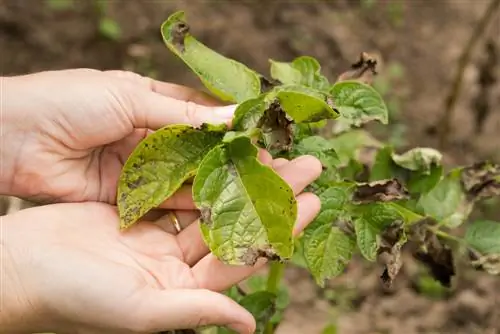
Potato blight is first shown by twisting of the leaves
“A single infected seed potato is enough to destroy the harvest of an entire cultivated area.”
Infection with potato blight is shown by the following symptoms:
- Yellowing of the leaves at the beginning of infection
- subsequently formation of gray or brown leaf spots
- Formation of white-grey fungal turf on the undersides of the leaves
- The entire potato plant dies within a few days
- Infestation of tubers does not always occur at the same time as late blight
- infected tubers have gray, sunken spots
- Brown coloring of the tubers under the peel
The tricky thing about tuber rot is that infected potatoes look he althy for a long time and only begin to rot when stored for a long time. For this reason, you should not build earth rents and the like near the cultivated areas, and no tubers should be left on the field after the harvest.
Fighting potato blight

If potato blight has affected the plants, cut off the leaves immediately and dispose of them. Under no circumstances should you throw the infected plant parts into the compost, as fungal spores can last there for a very long time. Next year these may cause a new infection. It is better to dispose of the leaves in the residual waste. The tubers themselves can remain in the soil for at least three weeks after the leaves have been removed until the shell is firm.
Excursus
Plant potatoes in a different place every year
Since the fungal spores survive in the soil and in plant residues for a very long time, you should change the cultivation areas for nightshade plants such as tomatoes and potatoes every year. This is especially true if an infection occurred in the previous year. Instead, plant marigolds in the bed as they clean the soil.
Effectively prevent potato blight
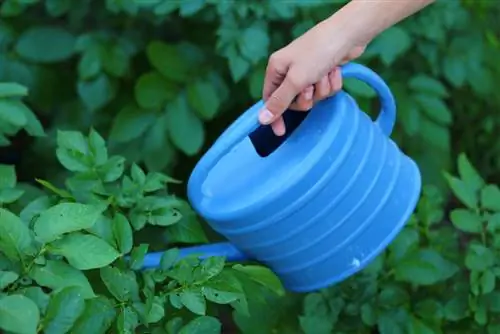
The potato herb should, if possible, not be wet when watering
However, the most important measure to combat potato blight is effective prevention. The following tips will help you contain the disease:
- Be sure to adhere to the recommended planting distances and do not plant the potatoes too close together.
- Do not plant potatoes and tomatoes (and other nightshades) in close proximity to each other.
- Change the cultivated area every year and maintain crop rotation.
- Never pour from above, but always directly onto the ground.
- If possible, water early in the morning so that the moisture can dry off quickly.
- Watering in the evening, however, promotes fungal infestation.
- Fertilize moderately and especially avoid over-fertilizing with nitrogen.
- Support the plants' defense system with home-made plant manure (e.g. field horsetail or garlic tea) and rock dust.
Pre-germinating the tubers, which you can position in shallow bowls or egg cartons in a bright and frost-free place in early spring, also has a good preventive effect against potato rot. After just a few weeks, under the influence of light, short, green germs sprout from the eyes of the tubers. This pre-germination gives the plants a head start in growth so that they mature earlier and infection with the fungal disease can be prevented at an early stage.
Excursus
These potato varieties are resistant to potato blight
There are no varieties that are truly resistant to potato blight due to the diversity of the pathogen. However, you can instead use varieties that are tolerant or insensitive to the disease and are less likely to become infected. This particularly applies to potatoes of the varieties 'Annabelle', 'Bettina', 'Caprice', 'Donella', 'Granola', 'Lolita' and 'Mariola', but also to some commercial varieties.
Frequently asked questions
Can you still eat tubers affected by potato blight?
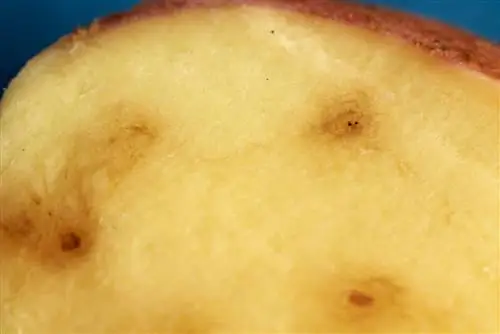
Potatoes affected by potato blight should not be eaten
Since the fungus that causes the disease, Phytophthora infestans, produces carcinogenic toxins during its metabolism, it is not advisable to use even slightly infected potato tubers. Even cutting out brownish areas is of no use in this case, as invisible fungal threads still run through the potatoes. Therefore, remove and dispose of infected tubers and do not eat them. These should also not be fed to animals.
Is potato blight and late blight of tomatoes the same disease?
In fact, late blight and potato blight on tomatoes are caused by the same fungal pathogen, Phytophthora infestans. Therefore, it is the same disease, which is why you should not grow nightshades in close proximity to each other or consecutively in the same bed.
tip Piling up the potatoes also protects a certain amount of cabbage from rotting. It is best to carry out this step in early summer.


